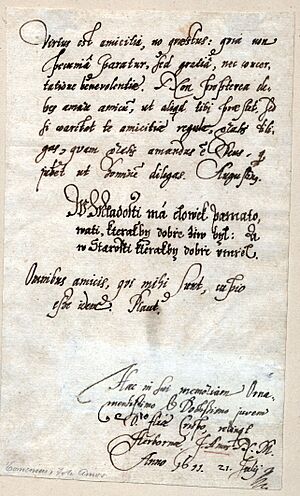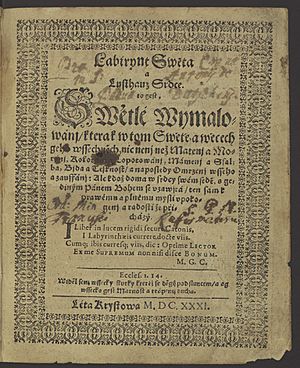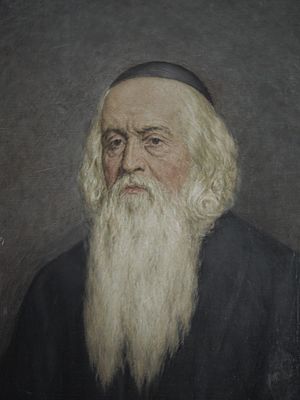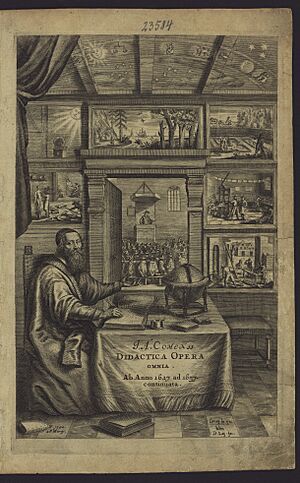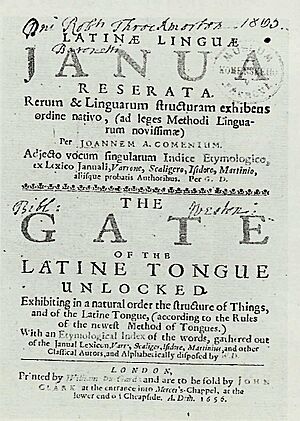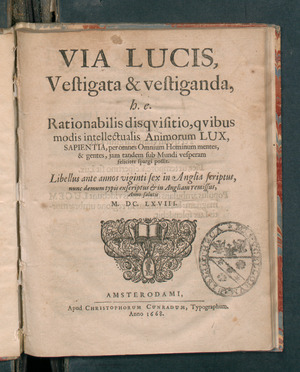John Amos Comenius facts for kids
Quick facts for kids The Right Reverend John Amos Comenius |
|
|---|---|
| Bishop of the Unity of the Brethren | |
 |
|
| Personal details | |
| Birth name | Jan Amos Komenský Johann Amos Comenius |
| Born | 28 March 1592 Nivnice, Moravia, Crown of Bohemia (now the Czech Republic) |
| Died | 15 November 1670 (aged 78) Amsterdam, Holland, Dutch Republic (now the Netherlands) |
| Denomination | Moravian Church
Philosophy career |
| Education | Herborn Academy (1611–1613) University of Heidelberg (1613–1614) |
|
Main interests
|
Theology, philosophy of education |
|
Notable ideas
|
Pansophism |
|
Influenced
|
|
John Amos Comenius (born March 28, 1592 – died November 15, 1670) was a Czech thinker and teacher. Many people call him the "father of modern education." He was also a bishop in the Moravian Church.
Comenius believed that everyone should get an education. This included poor children and girls. He thought learning should be fun and easy to understand. He created new ways of teaching, like using pictures in textbooks. He also believed in learning throughout your whole life.
He lived and worked in many countries. These included Sweden, Poland, England, and the Netherlands.
Contents
Comenius's Early Life and Work

John Amos Comenius was born in 1592 in Moravia, which is now part of the Czech Republic. His exact birthplace is not known for sure. His family belonged to the Moravian Brethren, a Protestant church. Comenius later became an important leader in this church.
Sadly, his parents and two of his sisters died in 1604. Young John then went to live with his aunt. Because he was poor, he started school later than most children. He was 16 when he began attending a Latin school.
He continued his studies at universities in Germany. There, he learned that teaching should be practical. He believed that what you learn should be useful in real life.
Becoming a Teacher and Pastor
Comenius became a school principal in Přerov. In 1616, he became a minister in the Moravian Brethren church. Four years later, he became a pastor and principal in Fulnek. This was a very important part of his life.
However, religious wars caused him to lose everything in 1621. He had to leave his home in 1627 because Protestants were being treated badly. He became a religious refugee.
Comenius's Educational Ideas
Comenius wrote a famous book called Janua linguarum reserata (The Gate of Languages Unlocked). This book helped him become well-known across Europe. Even though he was famous, he still had to move around a lot. He found safety in Leszno, Poland. There, he led a school and cared for the Czech and Moravian churches.
In 1638, the government of Sweden asked him for help. They wanted him to create a plan for their schools.
Organizing Knowledge for Everyone
Comenius also wanted to organize all human knowledge. He believed that everything we know could be put into a system. This idea is called Pansophism. He thought that if knowledge was organized well, every child could understand it.
He tried to create a language where you couldn't say false things. His ideas about organizing knowledge appeared in his textbooks. These books tried to make all human knowledge easy for children to grasp.
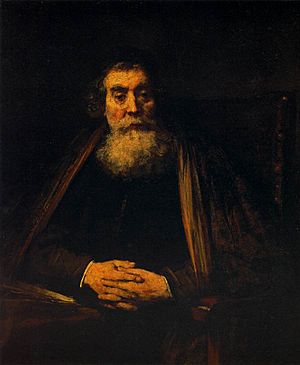
In 1641, the English parliament asked him to help improve their public education system. But the English Civil War stopped this project. Comenius later moved to Sweden to work with Queen Christina on school reforms.
He then went to Elbląg in Poland. In 1650, a princess named Zsuzsanna Lorántffy invited him to Hungary. He taught there until 1654 and wrote some of his most important books.
Challenges and Later Life
Comenius returned to Leszno, Poland. In 1655, a war broke out. He supported the Swedish side. Because of this, Polish Catholic fighters burned his house, his writings, and the school's printing press in 1656. Many of his important works were destroyed.
After this, he found safety in Amsterdam, in the Netherlands. He died there in 1670. He was buried in Naarden, a town nearby. You can visit his grave and a museum about him there.
Comenius's Impact on Education
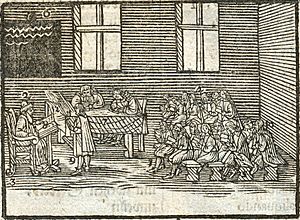
Comenius had a huge impact on how we teach today. He was a teacher and helped organize schools. He worked in his home country, Sweden, and the Netherlands. In his book Didactica Magna (Great Didactic), he described a school system. This system is very similar to what we have today: kindergarten, elementary school, middle school, high school, and university.
He also developed the idea of "education according to nature." This means teaching in a way that fits how children naturally learn. His ideas were as important for education as the ideas of Francis Bacon and René Descartes were for science and philosophy. Comenius was one of the first to use these new ways of thinking to organize education.
New Textbooks and Teaching Methods
Comenius also changed how textbooks were made. His book Janua Linguarum Reserata (The Gate of Tongues Unlocked) was published in 1631. It was followed by other books like Vestibulum and Atrium.
In 1658, he published Orbis Pictus (The Visible World in Pictures). This was a very famous school textbook. It was one of the first successful books to use pictures to help children learn.
His textbooks were based on simple ideas:
- Learning new languages by using your own language first.
- Learning ideas by looking at objects, not just words.
- Starting with things children know well to teach them new things.
- Giving children a full understanding of their world. This includes their surroundings, people, religion, and morals.
- Making learning fun, not a chore.
- Making sure everyone can get an education.
Comenius's influence on education has been recognized for a long time. Many educators celebrate his birthday. A society was even formed to study and publish his works.
Comenius's Religious Beliefs
John Amos Comenius was a bishop in the Unity of the Brethren church. This church followed the teachings of Jan Hus. One of his most famous religious books is Labyrinth of the World and Paradise of the Heart. In this book, he writes about how the world can be confusing. He believed that true peace comes from within your heart, where Christ should be.
In another book, Unum Necessarium (Only One is Needed), he talks about life's problems. He offers simple solutions. He also admitted that he sometimes got lost in his own beliefs about prophecies.
Comenius also wrote about music. He believed that music, both singing and playing instruments, was important for education.
Comenius's Family
One of Comenius's daughters, Elisabeth, married Peter Figulus. Their son, Daniel Ernst Jablonski, was Comenius's grandson. He later became a high-ranking pastor in Berlin. He also met Count Nicolaus Ludwig Zinzendorf. Zinzendorf became an important leader in the renewed Moravian Brethren's Church, just like Comenius.
Comenius's Legacy
The Comenius Medal is a special award from UNESCO. It honors great achievements in education. This award is named after Comenius. Peter Drucker, a famous writer, said that Comenius invented textbooks.
In the Czech Republic
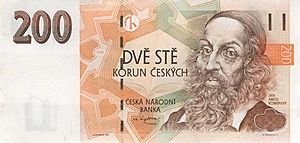
In the 1800s, Czech people saw Comenius as a hero. He became a symbol of the Czech nation. This idea is still strong today.
The Czech Republic celebrates March 28, Comenius's birthday, as Teachers' Day. A university in Prague is named after him. A project to teach languages to teachers was also named after his book, Janua linguarum reserata.
An asteroid, 1861 Komenský, is also named in his honor.
Elsewhere in Europe
In Hungary, a teacher's college is named after him. Many schools in Germany are also named after Comenius. In North Macedonia, a school built by the Czechoslovak government was named after him.
In Poland, the Comenius Foundation helps give equal chances to young children. In Slovakia, Comenius University was founded in 1919. It was the first university to offer courses in Slovak.
The Italian film director Roberto Rossellini used Comenius's ideas in his own teaching methods. Comenius is also remembered in the Calendar of Saints in Germany on November 16.
In the United States
In 1892, Comenius Hall was built at Moravian College in Pennsylvania. It is the main classroom building. Educators in many places celebrated Comenius's 300th birthday in 1892. A society was formed to study his works.
Salem College in North Carolina holds an annual Comenius Symposium. This event discusses modern education issues. The Comenius Foundation in the US uses films to promote faith, learning, and love.
Comenius's Main Works

Comenius wrote many books in Latin and Czech. Here are some of his most important ones:
- Janua linguarum reserata (The Gate of Languages Unlocked), 1631
- Didactica magna (The Great Didactic), 1633–1638
- Via Lucis, Vestigata & Vestiganda (The Way of Light), 1641
- Opera didactica omnia (Writing on All Learning), 1657
- Orbis Pictus (The Visible World in Pictures), 1658
- Unum necessarium (The One Thing Needful), 1668
- Labyrint světa a ráj srdce (Labyrinth of the World and Paradise of the Heart), 1631
See also
 In Spanish: Comenio para niños
In Spanish: Comenio para niños
- Moravian College
- Didactic method
- Great Didactic


